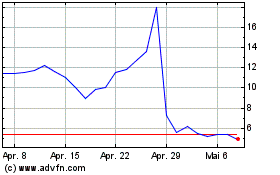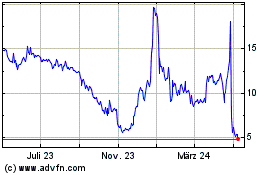Annovis Bio Measures Novel Biomarkers in Plasma of Parkinson’s Patients
02 November 2023 - 12:30PM
Business Wire
Buntanetap lowers the levels of TDP43, NfL, and
GFAP
Recent developments in biomarker research have enabled the
performance of measurements of important biomarkers in plasma
rather than in CSF (cerebrospinal fluid), making it possible to
follow the changes in biomarkers during the course of a
neurodegenerative disease while reducing patients’ burden.
This press release features multimedia. View
the full release here:
https://www.businesswire.com/news/home/20231102728977/en/
The figure shows the protein levels of
biomarkers in PD patients’ plasma treated with either placebo (n=5)
or 80mg buntanetap (n=10) at Day 28/End of Treatment. (Graphic:
Business Wire)
TDP-43 (TAR DNA-binding protein 43) was discovered by Lee &
Trojanowski at the University of Pennsylvania in 2007, and was
suggested to be associated with frontotemporal dementia (FTD, 1),.
Shaw’s lab in King’s College London associated TDP43 with
amyotrophic lateral sclerosis published in Science 2008 (ALS, 2).
More recently a number of papers in high profile journals have
associated the protein with other neurodegenerative diseases, such
as Alzheimer’s disease (AD, 3,4,5,8,9) and Parkinson’s disease (PD,
6,7). Of special interest, Dr. Ron Peterson from the Mayo Clinic
pointed out in his 2018 Neurology review that protein abnormalities
beyond amyloid and tau, including TDP-43 and α-synuclein, may
contribute to neurodegeneration and cognitive impairment (5).
TDP-43 turns out to be a neurotoxic aggregating protein that has
a normal function at normal levels, but when overexpressed it
aggregates and becomes toxic, just like Aβ and α-synuclein. It
impairs axonal transport, induces inflammation, and kills nerve
cells.
Two years ago, Annovis found that buntanetap inhibited
expression of TDP43 in vitro through an unbiased proteomics search
of proteins whose translation is regulated by buntanetap as
published (10) and in table below. Now we were able to see a
decrease of TDP43 in plasma of PD patients from our phase 2a study.
This was made possible through the new Quanterix Simoa TDP43 assay,
which detects both full-length and pathological, truncated forms of
the protein. The data revealed that 80mg buntanetap treatment (n=10
patients) indeed reduced the accumulation of TDP43 in patients’
plasma by 71.7% compared to placebo (n=5 patients), with a
statistically significant difference between placebo and treated
p=0.05. Buntanetap also showed a trend in reducing inflammatory
factor GFAP (Glial fibrillary acidic protein) and the axonal damage
biomarker NfL (Neurofilament-light chain).
Table shows changes in protein levels of neurotoxic proteins
whose mRNAs contain an atypical IRE (iron-responsive-element) and
control proteins whose mRNAs contain a canonical IRE (FTL, and
FHL1) in their 5′-UTR following buntanetap treatment of SH-SY5Y
cells. The column with the ratios shows by how much the protein
level goes down after the cells have been treated with buntanetap.
This data is from our unbiased proteomics study.
Symbol
Gene Name
After/Before Treatment
HTT
Huntingtin
0.479
APP
Amyloid beta protein
0.728
TARDBP
TAR DNA-binding protein 43 (TDP43)
0.761
SNCA
Alpha-synuclein
0.779
FTL
Ferritin light chain
0.978
FTH1
Ferritin heavy chain
0.975
These exciting new data support buntanetap’s unique mechanism of
action of reducing over-expression of multiple neurotoxic proteins
in disease situations, therefore, reducing inflammation and
neuronal damage, and preserving the neuronal function.
“We are pleasantly surprised to see a statistically significant
drop in TDP43 levels in just 10 patients and to see a strong trend
in GFAP and NfL. To our knowledge this is the first time that a
drug reduces the levels of TDP43 in humans, specifically here in PD
patients,” said Dr. Maccecchini. “These biomarker data not only
corroborate the mechanism of actions of buntanetap, but also
provide a new way to stratify patients and understand their disease
pathology. We will measure the above biomarkers in the plasma of
the patients that are presently in our phase 3 PD study to show the
effect our drug has on the course of the disease over a six-month
period.”
- Cairns NJ, Neumann M, Bigio EH, Holm IE, Troost D, Hatanpaa KJ,
Foong C, White CL 3rd, Schneider JA, Kretzschmar HA, Carter D,
Taylor-Reinwald L, Paulsmeyer K, Strider J, Gitcho M, Goate AM,
Morris JC, Mishra M, Kwong LK, Stieber A, Xu Y, Forman MS,
Trojanowski JQ, Lee VM, Mackenzie IR. TDP-43 in familial and
sporadic frontotemporal lobar degeneration with ubiquitin
inclusions. Am J Pathol. 2007 Jul;171(1):227-40. doi:
10.2353/ajpath.2007.070182. PMID: 17591968; PMCID: PMC1941578.
link
- Sreedharan J, Blair IP, Tripathi VB, Hu X, Vance C, Rogelj B,
Ackerley S, Durnall JC, Williams KL, Buratti E, Baralle F, de
Belleroche J, Mitchell JD, Leigh PN, Al-Chalabi A, Miller CC,
Nicholson G, Shaw CE. TDP-43 mutations in familial and sporadic
amyotrophic lateral sclerosis. Science. 2008 Mar
21;319(5870):1668-72. doi: 10.1126/science.1154584. Epub 2008 Feb
28. PMID: 18309045; PMCID: PMC7116650. link
- Meneses A, Koga S, O'Leary J, Dickson DW, Bu G, Zhao N. TDP-43
Pathology in Alzheimer's Disease. Mol Neurodegener. 2021 Dec
20;16(1):84. doi: 10.1186/s13024-021-00503-x. PMID: 34930382;
PMCID: PMC8691026. link
- Josephs KA, Whitwell JL, Tosakulwong N, Weigand SD, Murray ME,
Liesinger AM, Petrucelli L, Senjem ML, Ivnik RJ, Parisi JE,
Petersen RC, Dickson DW. TAR DNA-binding protein 43 and
pathological subtype of Alzheimer's disease impact clinical
features. Ann Neurol. 2015 Nov;78(5):697-709. doi:
10.1002/ana.24493. Epub 2015 Sep 16. PMID: 26224156; PMCID:
PMC4623932. link
- Peterson R. How early can we diagnose Alzheimer disease (and is
it sufficient)? Neurology® 2018;91:395-402. link
- Yamashita, R., Beck, G., Yonenobu, Y., Inoue, K., Mitsutake,
A., Ishiura, H., Hasegawa, M., Murayama, S. and Mochizuki, H.
(2022), TDP-43 Proteinopathy Presenting with Typical Symptoms of
Parkinson's Disease. Mov Disord, 37: 1561-1563. link
- Jo, M., Lee, S., Jeon, YM. et al. The role of TDP-43
propagation in neurodegenerative diseases: integrating insights
from clinical and experimental studies. Exp Mol Med 52, 1652–1662
(2020). https://doi.org/10.1038/s12276-020-00513-7 link
- Amador-Ortiz C, Lin WL, Ahmed Z, Personett D, Davies P, Duara
R, Graff-Radford NR, Hutton ML, Dickson DW. TDP-43 immunoreactivity
in hippocampal sclerosis and Alzheimer's disease. Ann Neurol. 2007
May;61(5):435-45. doi: 10.1002/ana.21154. PMID: 17469117; PMCID:
PMC2677204. link
- Foulds P, McAuley E, Gibbons L, Davidson Y, Pickering-Brown SM,
Neary D, Snowden JS, Allsop D, Mann DM. TDP-43 protein in plasma
may index TDP-43 brain pathology in Alzheimer's disease and
frontotemporal lobar degeneration. Acta Neuropathol. 2008
Aug;116(2):141-6. doi: 10.1007/s00401-008-0389-8. Epub 2008 May 28.
PMID: 18506455; PMCID: PMC2464623. link
- Chen XQ, Barrero CA, Vasquez-Del Carpio R, Reddy EP, Fecchio C,
Merali S, Deglincerti A, Fang C, Rogers J, Maccecchini ML. Posiphen
Reduces the Levels of Huntingtin Protein through Translation
Suppression. Pharmaceutics. 2021 Dec 7;13(12):2109. doi:
10.3390/pharmaceutics13122109. PMID: 34959389; PMCID: PMC8708689.
link
View source
version on businesswire.com: https://www.businesswire.com/news/home/20231102728977/en/
Maria Maccecchini maccecchini@annovisbio.com
Annovis Bio (NYSE:ANVS)
Historical Stock Chart
Von Mär 2024 bis Apr 2024

Annovis Bio (NYSE:ANVS)
Historical Stock Chart
Von Apr 2023 bis Apr 2024
